In January 2007, Apple launched the iPhone with the promise that it would "redefine the mobile phone." As a result, Japan is awash in smartphones, the popularization of which has led to significant lifestyle changes. But what has changed specifically?
Thanks to a joint study carried out by Video Research Ltd. and the Media Innovation Research Division of Dentsu Innovation Institute, we have begun to see the outline of those changes. So, how are Japanese people interacting with smartphones? In this article, we present some of the study's findings.
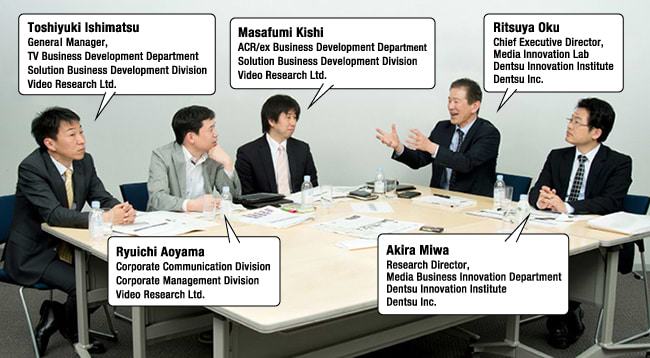
Fact 1
Excluding teens and the F3 segment (females, aged over 50) of the population, smartphones and feature phones have more than 100% penetration rate.
Many businessmen own two phones
Simultaneous ownership of two mobile phones is most common among males aged 35?69. The factor driving this is thought to be the high volume of work-related emails and voice calls. Users receive work documents using a smartphone, while a conventional low-end mobile phone is considered sufficient to handle general work-related communication.
Smartphones are used by approximately 90% of people aged 20?34, who will represent the core segment driving consumption from now on. The corresponding figure for teenagers is 70%. It is still unclear whether males aged 35 and over will remain loyal to the feature phone platform.
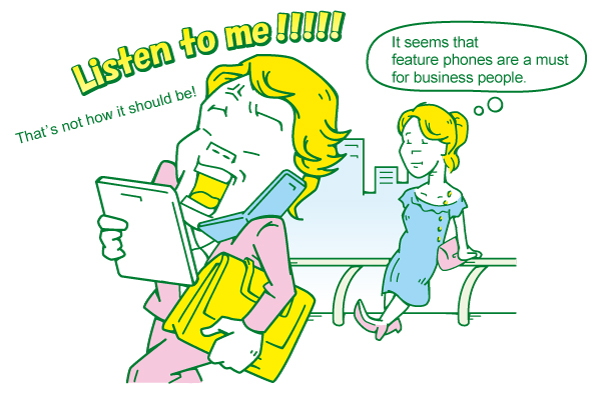
Research team comment: Japan's '100-million-smartphone era' is just around the corner
According to the most recent data (January 2015), excluding teens and the F3 segment (females, aged over 50) of the population, since April 2014 all age groups have had an average ownership rate exceeding 100% (smartphones and feature phones combined), reflecting almost nationwide multiple device ownership.
Assuming that many current feature-phone users will migrate to smartphones, it soon won't be possible to discuss consumer behavior without reference to smartphone use.
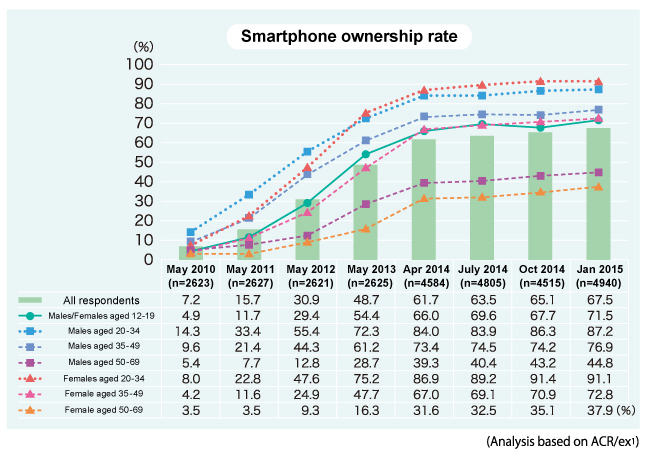
| Note: | Smartphone ownership rate survey targets include (a) males and females aged 12?69 years, surveyed between May 2010 and May 2013, who live within a 30km radius of central Tokyo; as well as (b) males and females aged 12?69 years, surveyed between April 2014 and January 2015, who live within a 50km radius of central Tokyo. |
Fact 2
Teens and the M1 segment (males, aged 20?34) use smartphones in their own rooms, while adult females use smartphones in the living room.
Morning, lunchtime and mid-to-late evening are the three peak usage times
Teenagers and people in the M1 segment (males, aged 20?34) tend to use smartphones alone in their own rooms. For teenagers using smartphones, the boundary between study and communication with friends is blurred.
Overall, there are three peaks in smartphone usage on weekdays?during the morning commute, at lunchtime and during mid-to-late evening.
The daily usage peak time across all age segments is between 8pm and midnight, while usage time at home is longer than that outside the home.

Research team comment: Usage at home is greater than that outside the home
Contrary to what might have been expected, it has been shown that people use smartphones longer at home than when they are outside the home. Revealed by quantitative data, this fact suggests the need for more detailed research into aspects such as the relationship between the use of smartphones and other devices.
However, females aged 20 years and over use their smartphones a lot when not in their rooms. This may be due to the long time they spend in family-shared space.
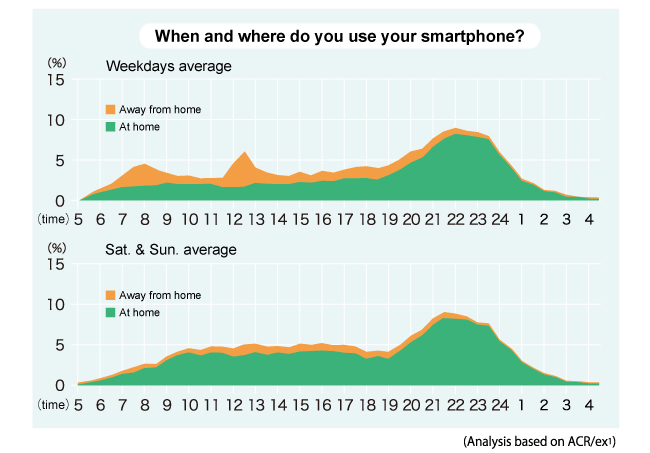
| Note: | A survey of smartphone users was carried out from October to December 2014. The targets were males and females, aged 12?69 years, living within a 50km radius of central Tokyo. Survey data also reveals that women aged 20?34 (the F1 segment) use their smartphones a lot late on Saturday and Sunday nights, outside the home. |
Fact 3
There is a lot of activity over a short time?particularly among teenage girls
Smartphones are communication tools
It is common for those who open social network service (SNS) apps on their smartphones to do so repeatedly over a brief period and become terribly fidgety. While looking at the screen is a static activity, the user's conscious activity is extremely dynamic, so that in terms of app use frequency, a smartphone is a communication tool. As an integral part of the mobile phone's evolution, it is not used as an information-gathering tool, such as a handheld PC.
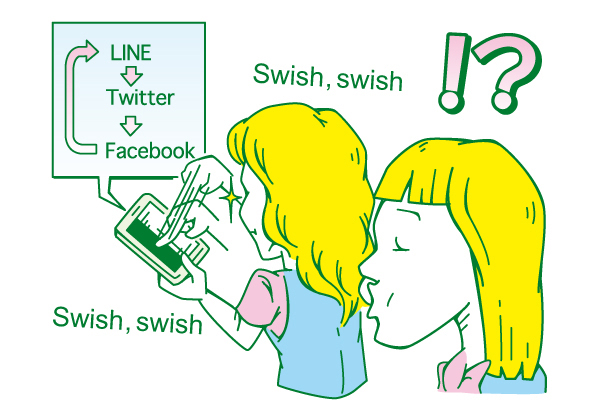
Research team comment: Young people try to avoid 'reading and not responding to messages'
Among the various SNSs, the use of LINE stands out. Teenage girls typically open their LINE app and then, within 10 seconds, look at content on a web-browser app, before opening other SNS apps, such as Twitter. The study has provided data verifying that young people exhibit reflexive behavior in a bid to avoid 'reading and not responding to messages'.
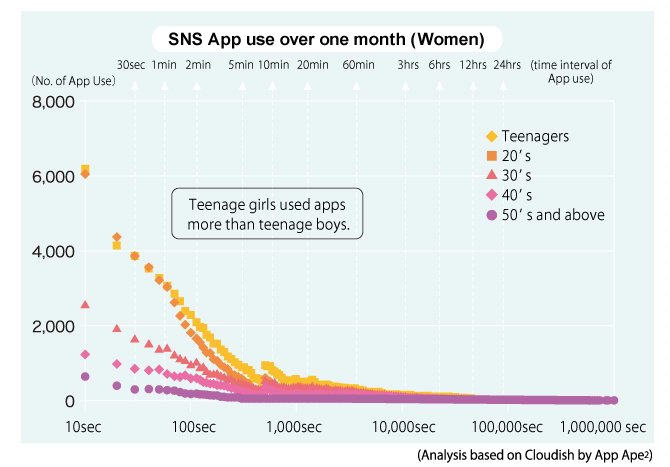
| Note: | Nationwide app use data collected from 1,000 men and women aged 15?69 was analyzed. Data was gathered during the period October 1?31, 2014. The above graph indicates the time (in seconds) between the opening of an initial SNS app and the opening of the next SNS app. |
Fact 4
Segments F2 (females, aged 35?49) and F3 (females, aged over 50) of society love smartphone games
Teenage girls use game apps four times a day; women in their 50s use them about ten times a day
The rate of game app usage tends to be comparatively high among men and women in all age groups. The graph below shows a breakdown of women's game-playing activities for specific age groups. Teenagers use game apps around four times a day, women in their 40s eight times a day and those in their 50s some 10 times a day, making older women the most enthusiastic game app users.
One of the particular characteristics of this study is that it also reveals usage of game sub-categories, such as educational games, puzzles and casual games, and also provides information on specific app usage.
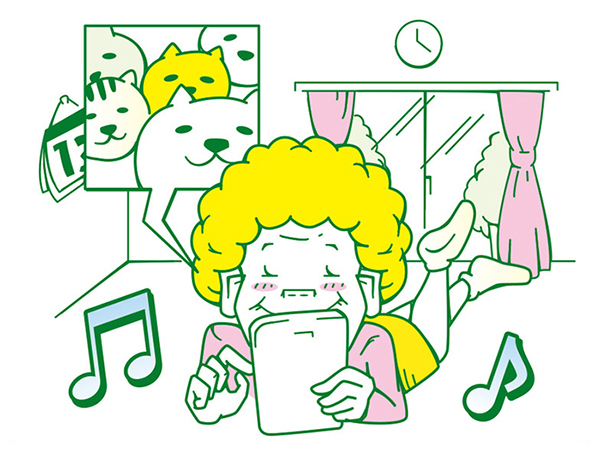
Research team comment: Enjoying light-hearted games
As women get older, their interest increases in nurturing games, puzzles and lighthearted games with cute characters and heartwarming themes. These can be enjoyed for relaxation, rather than games that involve fighting or high levels of tension.
Our analysis implies that this trend shows a migration away from mini-games on feature phones and brain-training games on dedicated game consoles. We also note that women in their 20s, 30s and 40s use educational games that may be related to their childrearing roles.
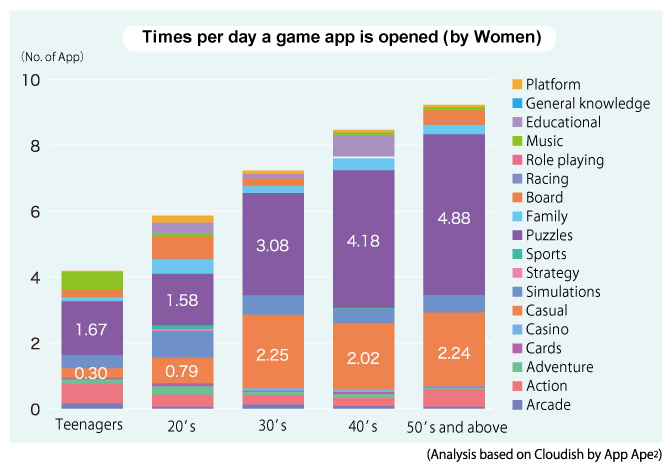
| Note: | Nationwide app use data collected from 1,000 men and women aged 15?69 was analyzed. Data was gathered during the period October 1?31, 2014. Apps were classified into 18 categories. |
Additional information revealed
1. Redefinition of communication
Based on use of the LINE app, usage featuring repetitive, high-frequency communication is generally common across all smartphone user segments. The frequent exchange of information and messages?the sphere of instant communication?has emerged along with the popularity of smartphones.
2. 10pm is the peak for smartphone usage
The tendency to use smartphones at home more than outside the home is strong, and the usage peak time across all age segments is 10pm. Planning based on this trend is needed from the perspective of mass and digital media.
3. Teenage girls prefer visual media to text
Rather than text-based media, teenage girls prefer photograph-driven apps, SNSs and other media. They are also very active communicators through them. This might be termed "image communication."
4. PCs are strong favorites for video sharing
Males in their 20s and 30s use PCs to watch videos on sites such as YouTube and Niconico. Although there may seem to be a strong bias toward the use of smartphones, users are actually quite shrewd in their choice of different media for different purposes.
Note
1ACR/ex
A report provided by Video Research, uses a multifaceted approach to examine consumers, brands and media. Some 17,000 consumers, aged 12?69 years, were targeted in seven key regions nationwide. They were asked questions reflecting their consumer attributes, product involvement and media contact. Among the targets, approximately 4,800 consumers living within a 50km radius of central Tokyo participated in the survey for one year.
2Cloudish by App Ape
Based on app usage data gathered from over 50,000 smartphone (Android) users, this research platform is used for forecasting and analysis. It focuses on app usage trends broken down by time of day, day of the week, the relationships between different apps used and the life cycles of specific apps. The research is provided jointly by Video Research Interactive and Microsoft. One of the characteristics of the platform is the use of an Excel-based analysis template.
Research team members

Ritsuya Oku
Chief Executive Director, Media Innovation Lab
Dentsu Innovation Institute
Dentsu Inc.
Joined Dentsu after graduating from the School of Economics at Osaka University. After being involved in TV spot sales, he was appointed marketing manager of the Media and Marketing Division at Dentsu. Subsequently, he has worked at the Communication Design Center (CDC) and Dentsu Innovation Institute, and served as the deputy manager of the MC Planning Division. He has been in his current role since October 2010. He mainly conducts business-, audience- and technology-related research and development work, focusing on fields related to information and communications.
He is the co-author of both Neo-Digital Native no Tanjo (A Birth of Neo Digital Natives), published in March 2010 by Diamond Inc.; and of Joho Media Hakusho (A Research for Information and Media Society), also published by Diamond Inc.

Akira Miwa
Research Director, Media Business Innovation Department
Dentsu Innovation Institute
Dentsu Inc.
Since joining Dentsu, he mainly has been involved in research in the areas of information communication, digital devices, and content business at Dentsu Innovation Institute. He has also carried out consulting projects for public- and private-sector clients, with particular emphasis on the business vision-building process. He has managed research across a broad range of fields, including cameras, robotics and electronic books. Beginning in July 2012, he undertook projects covering information and media in general at Dentsu's Media Business Innovation Department.
| Note: | The above article has been reproduced from the articles published on Web Dentsu-ho on June 22 and 24, 2015. |
